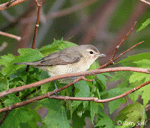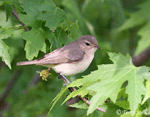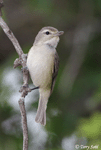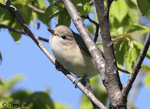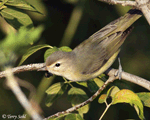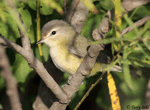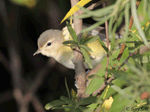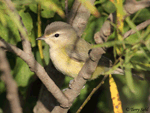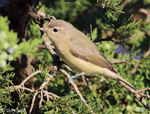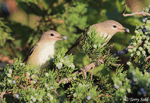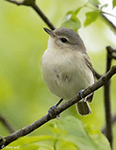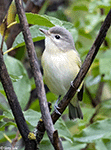Warbling Vireo
Vireo gilvus
| Length: 5.25 inches | Wingspan: 8.75 inches | Seasonality: Summer |
| ID Keys: Gray overall, with darker upperparts and lighter underparts, sometimes with a wash of yellow (particularly in the spring). White eyebrow. | ||
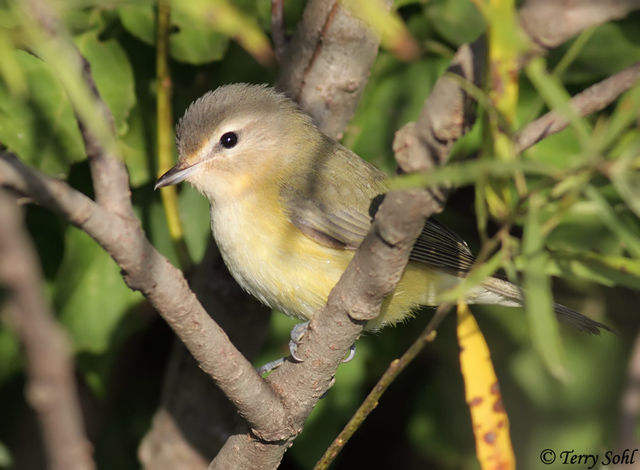 The Warbling Vireo is a relatively plain looking bird with a musical warbling song.
They are often found high in the treetops, and may be known by song more
than by appearance for many people. They can be found across much of
North America, including South Dakota, where they are not only found during
spring and fall migration, but are common summer breeding birds across the
state.. The eastern and western birds sing slightly different songs,
leading some to believe they should be classified as separate species, but
they are virtually identical in appearance, with western US birds being
slightly less colorful than eastern US birds.
The Warbling Vireo is a relatively plain looking bird with a musical warbling song.
They are often found high in the treetops, and may be known by song more
than by appearance for many people. They can be found across much of
North America, including South Dakota, where they are not only found during
spring and fall migration, but are common summer breeding birds across the
state.. The eastern and western birds sing slightly different songs,
leading some to believe they should be classified as separate species, but
they are virtually identical in appearance, with western US birds being
slightly less colorful than eastern US birds.
Habitat:
Uses open deciduous or mixed forest during the summer breeding season, especially along woodland edges and clearings. They can also be found in isolated groves of trees in otherwise largely unforested land, such as farmsteads and shelterbelts, riparian areas, and suburban settings. They winter in open woods in the tropics.
Diet:
Primarily feeds on insects in all seasons. Will also eat spiders, snails, fruits, and berries.
Behavior:
Forages by moving briskly through foliage and gleaning insects from leaves and branches. They will also sometimes hover to glean insects.
Nesting:
Late May through mid-July. The nest of a Warbling Vireo is a cup of grasses, sedges, strips of bark, leaves, and other plant material, placed in the fork of a tree. The female lays between 3 and 5 eggs, and both parents help to incubate them. When the eggs hatch, both parents help to feed the young. The young fledge after about 2 weeks.
Song:
A fast musical warbling, with a high degree of variability (even from the same bird). Warbling Vireos also have a variety of calls, including a harsh scolding or alarm call, and other shorter, crisp notes.
- Click to hear to hear the song of a Warbling Vireo1
- Click here to hear the harsh scolding call of a Warbling Vireo2
- Click to hear various calls of a Warbling Vireo3
Migration:
Summers throughout most of the continental United States except for portions of the South, also in much of western Canada. Winters in Mexico and points south. In South Dakota they are found in migration, but also as summer breeding residents throughout the state.
Interactive eBird map:
Click here to access an interactive eBird map of Warbling Vireo sightings
Similar Species:
Warbling Vireos may potentially be confused with multiple other vireos that can be found in South Dakota.
- Philadelphia Vireo - Seasonality may be one clue to differentiating between Philadelphia and Warbling Vireos, as Philadelphia Vireos are only migrants through South Dakota, while Warbling Vireos are summer breeding birds throughout the state. Birds found in June, July, and most of August are thus almost certainly Warbling Vireos. In terms of appearance, the two species can be very similar looking. In general, Philadelphia Vireos are more brightly colored, with more of a yellowish tone on their underparts. Warbling Vireos are usually more drab, but birds in fresh spring plumage can be difficult to differentiate, as spring Warbling Vireos may have a significant yellow wash on their flanks (see photo of bird above). However, note the yellow wash on a Warbling Vireo is generally restricted to the flanks, and birds have a light throat. Philadelphia Vireos in contrast have yellow on the throat and upper breast.
- Bell's Vireo - Habitat may be one clue to differentiating Bell's Vireo from a Warbling Vireo. Bell's Vireo prefer low, brushy areas, including open shrubland with few trees. Warbling Vireos prefer deciduous forests and are usually foraging in the forest canopy. In appearance, facial plumage is one clue. Warbling Vireos don't have that strong of a facial pattern, but it is more evident than that of a Bell's Vireo. Warbling Vireos have a darker crown that contrasts with a white "eyebrow", while there's less contrast on the face of a Bell's vireo. Warbling Vireos have a weak whitish wingbar, while the wings on a Warbling Vireo are plainer.
- Red-eyed Vireo - Red-eyed Vireos can often be found in the same deciduous forest habitats as Warbling Vireos. They have a much stronger facial pattern, with a dark cap and white eyebrow that strongly contrast with each other. The namesake red eye of a Red-eyed Vireo is an obvious identification feature, but it can sometimes be difficult to see in field conditions. Note the yellowish tones (or greenish-yellow) on a Red-eyed Vireo is generally confined to the bird's upperparts (nape, wings, and back), while the yellowish wash on a spring Warbling vireo is found on its flanks.
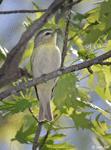 |
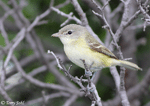 |
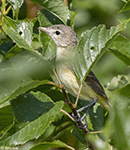 |
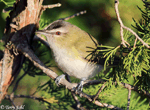 |
| Philadelphia Vireo | Bell's Vireo | Bell's Vireo | Red-eyed Vireo |
Conservation Status: Numbers of Warbling Vireo are probably greater than before European settlement of North America, due to the vast increases in "edge" habitat created through fragmentation and clearing of forest land. Systematic surveys in recent decades show generally stable trends, with increases in some areas. They are found across a very broad geographic area, are common in parts of that range, and have high overall numbers. The IUCN lists the Warbling Vireo as a species of "Least Concern".
Further Information:
Photo Information:
September 5th, 2011 - Minnehaha County, South Dakota - Terry Sohl
Additional Photos:
Click on the image chips or text links below for additional, higher-resolution Warbling Vireo photos.
Audio File Credits:
- 1Steve Hampton. Recorded in Yolo County, California on May 21st, 2020. Original recording and information is available on xeno-canto.
- 2Michael Harrison. Recorded in High River, Alberta on July 1st, 2018. Original recording and information available on xeno-canto.
- 3Andrew Spencer. Recorded in Chaffee County, Colorado on May 30th, 2012. Original recording and information available on xeno-canto.
| Click on the map below for a higher-resolution view |
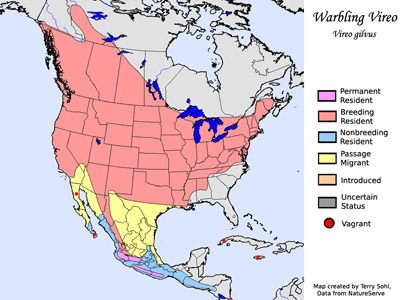 |
| South Dakota Status: Common summer breeding resident throughout the state. |
Additional Warbling Vireo Photos
Click for a higher-resolution version of these photos
